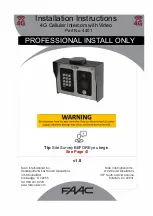
©Copyright Task Force Tips, Inc. 2011-2013
LIG-012 April 9, 2013 Rev02
12
6.0 USE WITH FOAM
The G-Force nozzle may be used with foam solutions. Refer to fi re service training for the proper use of foam.
WARNING
For Class B fi res, lack of foam or interruption in the foam stream can cause a break in the foam
blanket and greatly increase the risk of injury or death. Assure that: Application rate is suffi cient
(see NFPA 11 or foam manufacturer’s recommendations); Enough concentrate is on hand to
complete task (see NFPA for minimum duration time requirements); Foam logistics have been
carefully planned. Allow for such things as: Storage of foam in a location not exposed to the
hazard it protects; Personnel, equipment and technique to deliver foam at a rapid enough rate;
Removal of empty foam containers; Clear path to deliver foam, as hoses and other equipment
and vehicles are deployed.
WARNING
Improper use of foam can result in injury or damage to the environment. Follow foam
manufacturer’s instructions and fi re service training to avoid: Using wrong type of foam on
a fi re, i.e. Class A foam on a Class B fi re; Plunging foam into pools of burning liquid fuels;
Causing environmental damage; Directing stream at personnel.
WARNING
There is a wide variety of foam concentrates. Each user is responsible for verifying that any
foam concentrate chosen to be used with this unit has been tested to assure that the foam
obtained is suitable for the purpose intended.
6.1 FOAM ASPIRATING ATTACHMENTS
To increase the expansion ratio, Task Force Tips MX Foamjet (model FJ-MX-G) multi-expansion attachment or LX Foamjet (model
FJ-LX-G) low expansion attachment may be used with G-Force nozzles. These foam tubes attach and detach quickly from the
nozzle. Note: As expansion ratio is increased, the reach of the nozzle will be decreased due to the greater amount of bubbles
in the stream and their ability to penetrate the air. Generally the reach with foam is approximately 10% less than with water only.
Actual results will vary based on brand of foam, hardness of water, temperature, etc. See Foamjet instruction manual for specifi c
information.
7.0 USE OF G-FORCE NOZZLES
IT IS THE RESPONSIBILITY OF THE INDIVIDUAL FIRE DEPARTMENT OR AGENCY TO DETERMINE PHYSICAL CAPABILITIES
AND SUITABILITY FOR AN INDIVIDUAL’S USE OF THIS EQUIPMENT.
Many factors contribute to the extinguishment of a fi re. Among the most important is delivering water at a fl ow rate suffi cient to
absorb heat faster than it is being generated. The fl ow rate depends largely on the pump discharge pressure and hose friction loss.
It can be calculated using a hydraulic equation such as:
For additional information on calculating specifi c hose layouts, consult
an appropriate fi re service training manual, such as IFSTA, or A Guide to
Automatic Nozzles, or call TFT’s “Hydraulics Hotline” at 800-348-2686.
See www.tft.com for fl ow rates at various pump pressures.
PDP = NP+FL+DL+EL
PDP
= Pump discharge pressure in PSI
NP
= Nozzle pressure in PSI
FL
= Hose friction loss in PSI
DL
= Device loss in PSI
EL
= Elevation loss in PSI


































